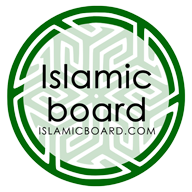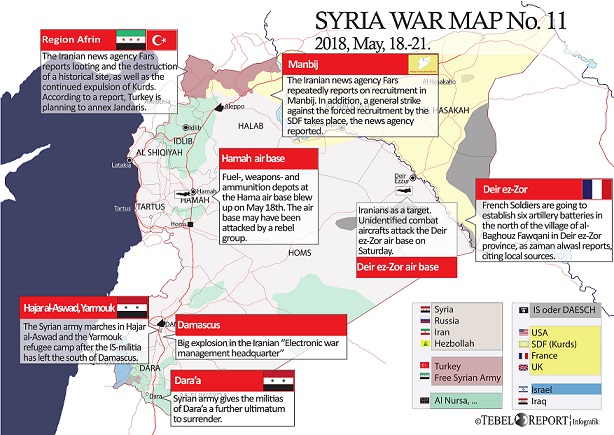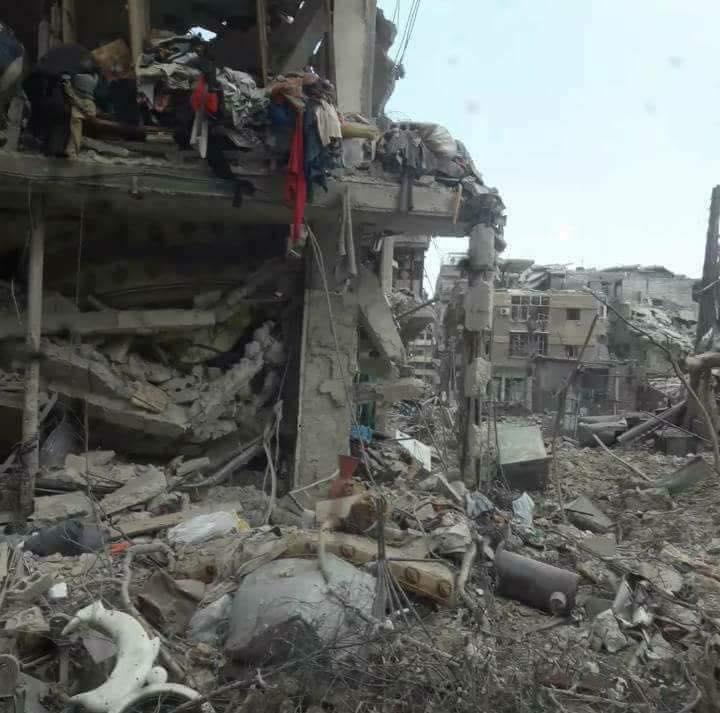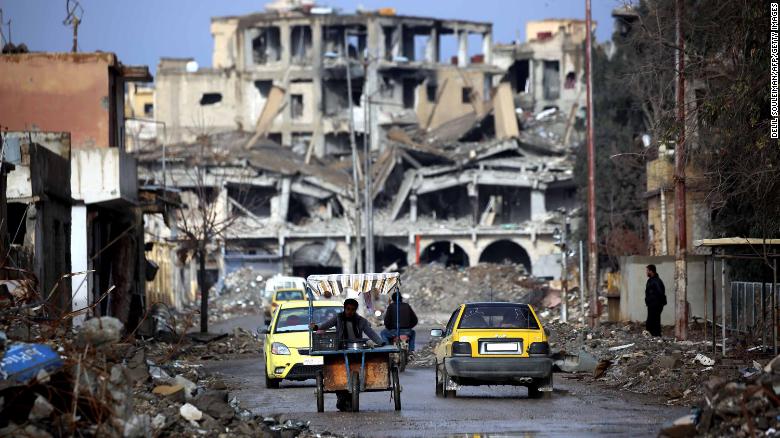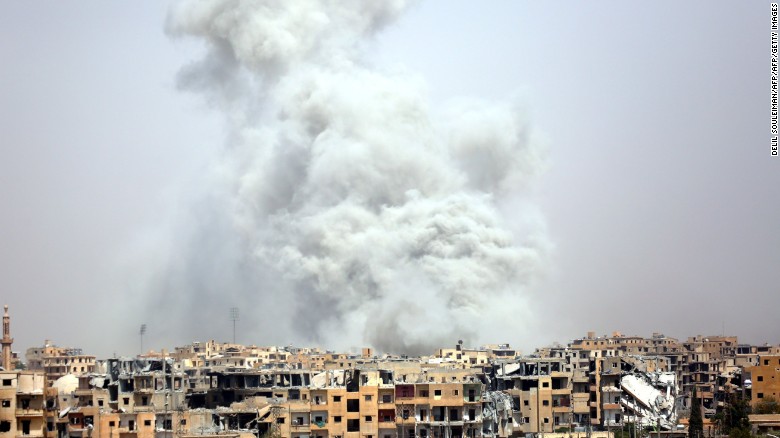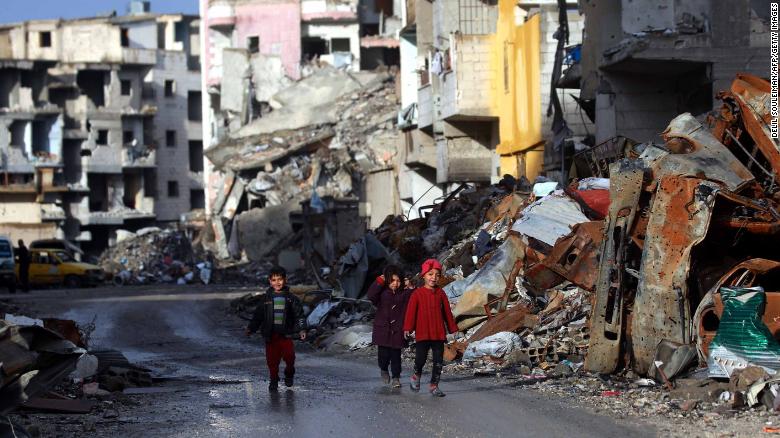[h=1]
A Syrian cleric loyal to the regime has condemned government troops and allied militias for looting homes in the recently recaptured Yarmouk Palestinian refugee camp.[/h]
Sheikh Mohammed al-Omari made on the remarks on Wednesday on his Facebook page before deleting the critical post, opposition news website Zaman al-Wasl reported.
"The victory was achieved by the grace of God then by the wise leadership," Omari, a Palestinian Syrian, said.
"But the flagrant looting has frustrated people. This has hurt the feeling of many people, especially the families of the martyrs and wounded who have risen to defend the country,"
Omari also appealed to President Bashar al-Assad to take action to stop regime troops from looting in the Damascus district.
Regime troops and allied militias have long been accused of pillaging civilian homes after capturing rebel-held areas.
Syrian troops seized control of Yarmouk and other neighbourhoods in the south of the capital Damascus on Monday after a month-long assault against the Islamic State group.
The offensive for Yarmouk has left the neighbourhood, once home to about 200,000 Palestinian refugees, catastrophically damaged.
Yarmouk has been so heavily battered by fighting that it was hard to picture daily life restarting there, the United Nations' Palestine refugee agency (UNRWA) said on Tuesday.
"Today Yarmouk lies in ruins, with hardly a house untouched by the conflict," spokesman Chris Gunness said.
Fighting over the years had whittled down Yarmouk's population to just hundreds by the time Syria's army began its assault last month.
Gunness said between 100 to 200 civilians were estimated to still be in Yarmouk, including people too old or sick to flee.
Yarmouk was, for decades, a bustling district where both Palestinians and Syrians lived.
It was placed under crippling siege a year after the uprising began in 2011.
[h=1]Syrian regime forces killed an elder woman in al Yarmouk Camp in Damascus city on May 18[/h]Mrs. Thahabiya Fahd Abo Rashed, from al Yarmouk Camp south of Damascus city, age 85, killed due to Syrian regime forces heavy bombing on al Yarmouk Camp, on May 18, 2018.
http://sn4hr.org/sites/news/2018/05...r-woman-al-yarmouk-camp-damascus-city-may-18/
[h=1]15 Palestinian refugees killed in Syrian regime shelling on Yarmouk camp[/h]
The bodies of 15 Palestinian refugees who were killed by regime shelling have been found in Yarmouk refugee camp, the Working Group for the Palestinians in Syria said yesterday.
The rights group went on to demand medical and civil defence teams be allowed access to the Palestinian refugee camp to recover the bodies from under the rubble.
Following the Assad regime’s brutal air raids against Syria’s largest refugee camp, the United Nations said the regime “turned it into a death camp”.
“The Yarmouk camp in Damascus lies today in ruins, with hardly a single building that has not been destroyed or damaged. The fighting has been particularly intense in the last month or more. Almost all the Palestine refugees who were there have now fled,” United Nations Secretary-General’s Spokesman Stéphane Dujarric
said last week.
https://www.middleeastmonitor.com/2...ed-in-syrian-regime-shelling-on-yarmouk-camp/
[h=1]Yarmouk, A Palestinian Tragedy Plays Out In Syria[/h]Yarmouk: Stories of building collapses and neighbors killed reverberate around the diaspora through voice-notes and pictures sent almost the minute fleeing residents emerge from the camp. In one, an elderly Palestinian man cries into his phone, “The street has become dust … my house is gone, gone!” to the sound of shelling behind him. Others recount civilians hiding in basements for days on end with no news, or elderly neighbors dying in their homes for nobody to rescue them.
The Yarmouk Camp for
Palestinian refugees and the areas of south Damascus have been the site of a grueling “zero-hour” offensive since April 19, as the Syrian government moved to wrest back control of the area from jihadi and rebel groups. On Monday, the last Islamic State fighters pulled out from Yarmouk and Hajar al-Aswad toward the deserts in Syria’s east, marking the first time the Syrian government has been in full control of the capital since the beginning of the
Syrian uprising and conflict.
Over the last month that the military operation has played out, the Syrian government’s consolidation over these areas was preceded by extensive “evacuations.” In a repeat of the kind of coercive agreements that have been imposed by the Syrian government and its allies on rebel-held, besieged areas like Daraya since 2016, the three partially besieged rebel-held villages of Yalda, Babila and Beit Sahem capitulated to reconciliation at the close of April and ultimately accepted forcible deportations north, according to the state news agency SANA. Tahrir al-Sham militants were bused out of northern Yarmouk, before Syrian rebel fighters and their families, as well as Palestinian refugees, in the last rebel-held pockets of south Damascus boarded buses bound for a series of rural camp settlements in Syria’s rebel-held north.
An earlier “de-escalation” agreement reached with Russian guarantees and Egyptian mediation in October 2017 failed to bring an end to violence. The villages have been at partial truce with the Syrian government since 2014.
While the evacuation deals are meant to offer civilians the choice to leave conflict zones and allow entry of humanitarian aid into war-afflicted areas, those in the areas view them as compulsory in the face of possible reprisals for staying.
Palestinian activist and photographer Hamada Hameed felt he had no choice but to flee south
Damascus, given that the rebel-held neighborhood he had called home since fleeing Yarmouk has now been returned to Syrian government and Russian control.
“The biggest mistake someone can make is to stay behind, regardless of what [the Syrian government] says about getting people to stay. Anyone who carried a camera, was an activist at some point … defected from the Syrian military or faces military service, they should not stay,” Hameed says. “Those who leave meanwhile head toward an unknown fate.”
And against the backdrop of the military operations and evacuations are the less widely disseminated scenes captured in the voice-notes and pictures, some of which were obtained by Mada Masr, from civilians who have remained in the south Damascus suburbs and Yarmouk living under almost daily bombardment. While buildings were turned to ruin and
Palestinians in and around the camp struggled to survive, the presence of various pro-government Palestinian forces in the battle may be an early indication about the future of a camp whose post-conflict reconstruction may level Yarmouk’s once varied social and political fabric.
At least 21 civilians have been reported killed, and 7,000 people — including 6,200 Palestinian refugees from Syria — displaced from their homes.
Convoy Number Five
Before the Islamic State’s departure from south Damascus, deportations did not go smoothly.
The fifth convoy to leave rebel-held south Damascus,
Qafleh raqam al-khamis, was held for almost a week at the last government checkpoint on the road to northern Syria at the beginning of May because of poor coordination between the Russian negotiators who brokered the deportation deal and the Turkish military present in the north. Others, however, blamed the delay on intra-rebel clashes then happening nearby. Passengers slept on buses at night, taking shelter from the sun by the roadside during the day.
New arrivals are being housed in camps for internally displaced persons in rural Idlib and Afrin that many inside the camps say are poorly serviced and far from what they signed up for as part of the April “reconciliation” agreement. Some are attempting the perilous journey to get smuggled across the border into
Turkey instead.
“There’s little food in the camp … no electricity and the camp is very far from any of the local markets. The closest one is about 20 km away,” explains Palestinian human rights defender Abdallah al-Khateeb, who was in one of the first buses to head north from south Damascus. “During the negotiations, the Russians said they’d contacted the Turkish government and that everyone evacuated would be allowed to enter Jarablus. The first two convoys entered, but the fifth was not allowed.”
According to the North Syria Response Coordination, some 9,250 people eventually evacuated north. However, sources inside the rebel-held villages of Yalda, Babila and Beit Sahem tell Mada Masr that the original number of names registered for evacuation could have been as high as 17,000 until word got back to civilians in south Damascus about Convoy Number Five and the lack of services being made available in the north and some decided not to go. Families have been separated as a result.
The northern entrance of Yarmouk was transformed into a military staging-post.
Following weeks of daily bombardment by
Syrian and Russian airstrikes, barrel bombs and artillery, as well as brutal street fighting, much of the south Damascus suburbs are in ruins.
Throughout the military offensive, government supporters raised doubts about the presence of civilians in the area. The pro-government
Al-Watan newspaper called into question claims that there are — or were — civilians still inside Yarmouk, and the Central channel of Hmeimem military base Facebook page dismissed what it called “allegations of civilian casualties,” claiming pro-government fighters were “only faced by extremists belonging to the
Islamic State terrorist organization.”
However, civilians either inside Yarmouk or who had recently fled described how “houses are being destroyed and people are trapped under the rubble.”
London-based monitor Action Group for Palestinians of Syria (AGPS) reported that Palestinian refugee Mahmoud al-Bash, his wife and infant child were rescued alive from under the rubble of their home on April 27 after it was bombarded by pro-government forces several days before. The family had been presumed dead, until Bash was discovered.
Earlier that month, husband and wife Mohamed and Haifa al-Hadba were taking shelter in their home when it was shelled, according to Yarmouk activists. With his wife injured, Mohamed made the difficult choice to carry her by night across the camp to the home of a relative. Hours after arriving, that building was also shelled and both of them died.
Local activists and AGPS say at least 35 Palestinians have been killed so far in this offensive, including 21 civilians.
Almost all of the 6,200 Palestinians who were still inside their homes in Yarmouk at the beginning of the offensive have fled into neighboring areas.
Control of Yarmouk’s future
Pro-government forces have been gearing up for the battle for south Damascus since the end of the eastern Ghouta campaign. The front lines were a who's-who of pro-government militia politics.
Aleppo-based Palestinian militia Liwa al-Quds dispatched forces to Yarmouk in April, fresh from the front-lines of
Eastern Ghouta, with one of its leading commanders promising that “after the liberation of Ghouta, we will … liberate Yarmouk.” Syrian military units followed, before Suheil al-Hassan’s Russian-backed Tiger Forces arrived in the area in mid-April. They joined a polyglot Syrian and Palestinian force of some several thousand men that included National Defence Forces, a privately funded Palestinian militia, as well as old-guard Palestinian factions including Fatah al-Intifada and Ahmad al-Jibril’s Popular Front for the Liberation of Palestine – General Command (PFLP-GC).
Many still believe they will return to the camp one day.
The northern entrance of Yarmouk was transformed into a military staging-post where tanks and armored vehicles sat side-by-side and troop movements were soundtracked by pro-government dabke songs. A so-called “camp of return” hosted by ageing Palestinian resistance fighters was set up to receive newly arrived fighters and calibrate the future of a place once known as the “capital of the Palestinian diaspora.”
Since then, former residents and observers tell Mada Masr that Yarmouk runs the risk of being erased. Should this happen to what was once Syria’s largest Palestinian community, questions will be raised as to the future of the Palestinian-Syrian community itself. Others believe the camp as it existed has gone forever, but that it will ultimately be rebuilt in some form.
An estimated one-fifth of Syria’s pre-war population of 560,000 Palestinians have fled the country. Almost all of the 438,000 who remain are largely reliant on aid. Internally displaced Palestinians in Damascus often talk of impossibly rising rents and prices, while in a post-conflict Syria, Palestinians will likely encounter similar legal difficulties as Syrian citizens attempting to return to their homes or recreate stable lives. Law 10/2018, effectively the blueprint for
the reconstruction of Syria, could dispossess those unable to prove ownership of their homes. And even then, vast swathes of Yarmouk and other camps around the country have been badly destroyed.
Despite all that the civilians of Yarmouk Camp have suffered — military offensives, siege, starvation, detention and displacement — many still believe they will return to the camp one day. Seventy years after partition plans and machine guns in olive groves brought the first Nakba, today it arrives by bus. But with the destruction and possible erasure of Yarmouk, the possibility of rebuilding the political and social history of the camp may already have been demolished forever.
https://www.worldcrunch.com/syria-crisis-1/yarmouk-a-palestinian-tragedy-plays-out-in-syria
There's only one thought that comes to Rami al-Sayed's mind when asked to describe an ongoing Syrian government
offensive against an ISIL pocket south of the capital, Damascus.
"Doomsday," says the 35-year-old. "It's like Judgement Day."
Al-Sayed is a former resident of Hajar al-Aswad, one of the neighbourhoods of the besieged Palestinian refugee camp of Yarmouk which is currently under attack by forces loyal to Syrian President Bashar al-Assad and Russian fighter jets.
Activists say at least 15 civilians have been killed and more than 100 wounded since the fierce push to retake Hajar al-Aswad, Tadamun and Beit Sahem - which make up a considerable chunk of Yarmouk - began on April 19.
Before the Syrian war started in 2011, the camp was home to Syria's largest Palestinian refugee population.
In the years that followed, most of its residents fled to other parts of Syria or neighbouring countries seeking refuge. In 2015 Yarmouk came under the control of the Islamic State of Iraq and the Levant (
ISIL, also known as ISIS) group.
The six-day operation by Syrian government forces and their allies to drive out ISIL fighters has now turned the camp into a "ghost town", al-Sayed, who is currently based in the nearby rebel-held town of Yalda, told Al Jazeera on Monday.
"No clinics, no doctors, no supplies - it's pretty much empty," he added.
"People are not able to leave to purchase things they need. If they leave, they have to walk miles before seeing another person in the street; it is that uncommon to see people outside."
[h=2]'Bigger siege'[/h] The
United Nations agency for Palestinian refugees (UNRWA) estimates that over the past few days some 5,000 Palestinians from Yarmouk have been displaced to Yalda. The agency, which cited "reports" for the figure, has not been able to provide assistance to the camp since 2015.
Local activists say there have been no "formal" evacuations, and those who managed to make it to neighbouring Yalda did so under a rebel-brokered agreement.
UNRWA spokesperson Chris Gunness told Al Jazeera that only 1,200 people remain inside Yarmouk, while activists in nearby towns held by rebel factions have given a similar figure.
READ MORE
[h=4]
Syria: Qalamoun fighters arrive in Aleppo after evacuation deal[/h]
Yarmouk residents have had little access to the outside world, owing to a lack of cell service and a government-imposed siege in place since 2012. Activists in the area say these obstacles have made documenting the number of people killed and wounded in the camp a daunting task.
"The humanitarian situation in Yarmouk is simply indescribable," Ammar al-Midani, one of several Yalda-based activists who work on compiling information from Hajar al-Aswad through their communication with trapped civilians, told Al Jazeera on Monday.
"From surface-to-surface missiles to barrel and cluster bombs and mortar fire, simply disastrous," al-Midani said.
At times, al-Midani says activists like him are unable to reach residents who are hiding underground, other times, he says, they manage to get through to their friends and family in the area.
"People are terrified, mostly hiding in man-made bunkers. No one is able to reach those in the heart of the camp because of ISIL's control of the area - it's a new kind of siege."
Since last week, Syrian government forces and their allies have intensified efforts to regain all ground near Damascus.
Besides Yarmouk, their goal is to also drive out fighters from rebel groups Jaish al-Islam and Hay'et Tahrir al-Sham, which remain in control of pockets such as the towns of Yalda, Babbila, and al-Qadam - all of which lie south of Damascus and only one kilometre away from Yarmouk.
[h=2]Palestinian leadership's silence[/h] On Tuesday, government forces launched air raids in Yalda, killing 10 fighters from Jaish al-Islam, according to activists.
Meanwhile, state-news agency SANA said on Tuesday that government forces were targeting ISIL "tunnels and trenches" in Yarmouk.
According to activists, more than 580 air raids struck Hajar al-Aswad and Tadamun since Thursday evening, the majority of which targeted "civilian basements".
On Sunday, Yarmouk's only hospital was totally put out of service after being destroyed in an air raid.
READ MORE
[h=4]
UN tries to restart Syria talks after regime advances[/h]
Both al-Midani and al-Sayed said the toll of 15 victims so far included only those whose deaths were able to be documented, while others remain "unfound, and unaccounted for under the rubble".
Residents of the besieged camp have called on Palestinian leaders, including the Palestinian Liberation Organization (PLO) - an umbrella of major Palestinian political parties - to help bring relief to the people of Yarmouk.
A journalist based in neighbouring Babbila, who identified himself only as Youssef, said people in the camp are puzzled as to why no one from the Palestinian leadership has spoken out about recent events affecting thousands of Palestinian refugees.
[h=2]'A war on stomachs'[/h] The escalation is the latest in a series of devastating episodes to have hit civilians in Yarmouk.
The camp was home to 160,000 Palestinian refugees before 2011. But as Syria slid into war, fighting between rebels and Syrian forces quickly extended to Yarmouk too, with residents paying the price of a deteriorating humanitarian situation.
[TABLE="class: image"]
[TR]
[TD]
[/TD]
[/TR]
[TR]
[TD="class: caption"]Residents in Yarmouk line up to receive food supplies in 2014 [AP/UNRWA][/TD]
[/TR]
[/TABLE]
Over the years, the lack of food and medicine amid the siege, coupled with heavy battles - including between rebel groups - and the seizure of the camp by ISIL in 2015, pushed many to negotiate evacuation deals.
Among those forced to leave was Majd al-Masry. Born in the camp, the Palestinian former paramedic is now based in Yalda and among those documenting violations taking place in Yarmouk.
The closure of the camp's only "lifeline"
, a corridor that led to Yalda, during the siege was one of the cruelest war tactics, al-Masry said.
"A war on stomachs; a war on health; and a psychological war," he said, summarising the three years he witnessed at the camp before leaving in 2015.
"Managing attacks from multiple fronts, and diseases like salmonella, kidney failure, typhoid fever, and more - this was my life," al-Masry said.
[h=2]'Annihilation'[/h] The Syrian government has since 2015 regained control of the majority of Syria, with opposition groups now restricted to the northern part of the country, namely Idlib province.
It has thus far managed to regain large swaths of land through a series of evacuation deals that usually come amid a military offensive.
On Monday, Syrian state TV reported that government forces were moving to encircle ISIL fighters from the nearby rebel-held suburbs in an attempt to land an evacuation deal or a withdrawal.
Activists Al Jazeera spoke to said the "destruction" campaign in Yarmouk was a "classic" tactic employed by the government before such a deal.
Amid similar circumstances earlier this month, the government regained
control of Eastern Ghouta, a major Damascus suburb that was once home to 400,000 people.
With the offensive in southern Damascus likely to mark the latest rebel defeat, the balance of power in Syria's
war- now in its eighth year, keeps tilting in favour of Assad and his allies.
However, activists say the situation in Yarmouk cannot be described as a "war".
"We can't say this is a war. In war, there are emergency medical teams, hospitals, shelters, a chance for a truce and for safe corridors," al-Sayed said.
"But here, it's annihilation."
https://www.aljazeera.com/news/2018...ar-stomachs-annihilation-180423212111918.html
What's the difference between Assad and Israel?
